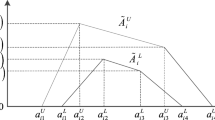Abstract
The process of supplier selection is one of the key processes in the industry since the suppliers play a key role in regards to the competitive advantage. It is therefore important to identify and select good suppliers. Supplier selection can be considered a decision-making problem with many criteria, which include both qualitative and quantitative elements, such as; purchase cost, quality level, supplier risk etc. The best process to be designed for selecting the suppliers may require a compromise in terms of these elements. A general framework, which combines Analytic Hierarchy Process (AHP), Fuzzy AHP and Genetic Algorithm (GA) in order to determine the best set of suppliers, is proposed in this study.
Similar content being viewed by others
References
Amid A., Ghodsypour S. H., O’Brien C. (2006) Fuzzy multi objective linear model for supplier selection in a supplier chain. International Journal of Production Economics 104: 394–407
Chan F. T. S., Kumar N. (2007) Global supplier development considering risk factors using fuzzy extended AHP-based approach. Omega 35(4): 417–431
Chan F. T. S., Chung S. H. (2005) Multi criterion genetic optimization for due date assigned distribution network problems. Decision Support Systems 39: 661–675
Ding, H., Benyoucef, L., & Xie, X. (2003). A simulation optimization approach using genetic search for supplier selection, Winter simulation conference, pp. 1260–1267.
Ellram L. M. (1990) The supplier selection decision in strategic partnerships. Journal of Purchasing Material Management 26(4): 8–14
Ghobadian, A., Stainer, A., & Kiss, T. (1993). A computerised vendor rating system. In Proceedings of the 1st international symposium on logistics, Nottingham, UK, pp. 321–328.
Ghodsypour S. H., O’Brien C. (1998) A decision support system for supplier selection using an integrated analytic hierarchy process and linear programming. International Journal of Production Economics 56: 199–212
Kwong C. K., Bai H. (2003) Determining the importance weights for the customer requirements in QFD using a fuzzy AHP with an extent analysis approach. IIE Transactions 35(7): 619–626
Roa C. P., Kiser G. E. (1980) ‘Educational buyers’ perceptions of vendor attributes. Journal of Purchasing Material Management 16: 25–30
Ross T. J. (1997) Fuzzy logic with engineering applications. McGraw-Hill Book Co, New York
Saaty T. L. (1980) The analytical hierarchy process. McGraw-Hill, Newyork
Saaty, T. L., & Alexander, J. M. (1981). Thinking with models: Mathematical models in the physical biological and social sciences, Chap. 8, London: Pergamum Press.
Stamm C. L., Golhar D. Y. (1993) JIT purchasing: Attribute classification and literature review. Production Planning Control 4(3): 273–282
Teltumbe A. (2000) A framework for evaluation ERP projects. International Journal of Production Research 38(17): 4507–4520
Wang H. S., Che Z. H. (2007) An integrated model for supplier selection decisions in configuration changes. Expert Systems with Applications 32(4): 1132–1140
Winkler L. R. (1990) Decision modelling and rational choice: AHP and utility theory. Management Science 36(3): 247–275
Xia W., Wu Z. (2007) Supplier selection with multiple criteria in volume discount environments. Omega 35: 494–504
Zadeh L. A. (1965) Fuzzy sets. Information and Control 8: 338–353
Author information
Authors and Affiliations
Corresponding author
Rights and permissions
About this article
Cite this article
Kubat, C., Yuce, B. A hybrid intelligent approach for supply chain management system. J Intell Manuf 23, 1237–1244 (2012). https://doi.org/10.1007/s10845-010-0431-2
Received:
Accepted:
Published:
Issue Date:
DOI: https://doi.org/10.1007/s10845-010-0431-2




